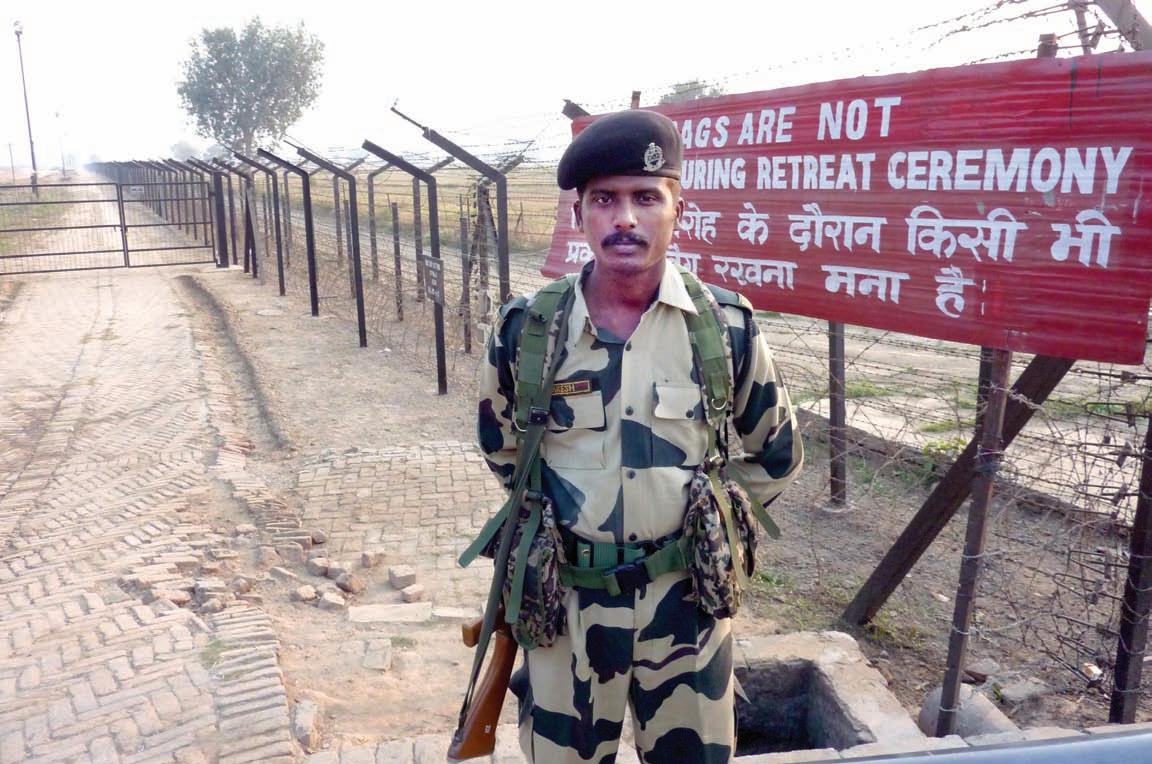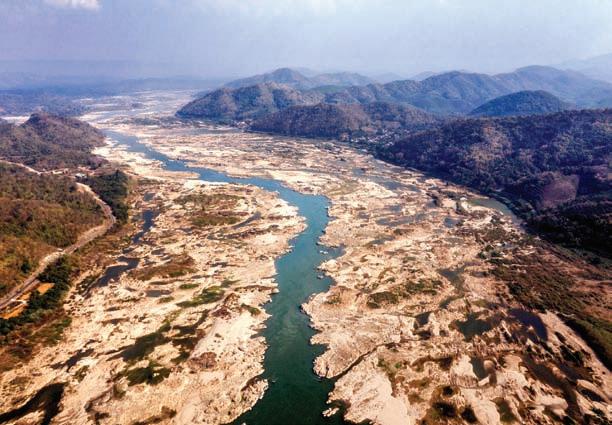
9 minute read
Nation’s Pride India and Its Unstable Neighbourhood
Prime Minister Narendra Modi with Chinese President Xi Jinping
INDIA AND ITS UNSTABLE NEIGHBOURHOOD
Advertisement
There is a need to pragmatically envision the future threats and challenges emanating from the instability of this India-ChinaPakistan strategic triangle, and it is sure that India would do well to engage with its neighbours for lasting peace, yet be fully prepared for a turbulent present and an even more turbulent future
By MAJ GEN CP SINGH (RETD)
T
he India-China-Pakistan strategic triangle in South Asia is the most unstable region in the world. Thanks to the Britishers, who gave us unsettled borders as a parting gift? In the last 70 years of Independence, we have not been able to finalise hundreds of km of disputed borders, which are presently depicted by various lines like LC, LOC, LAC and AGPL etc. This triangle of three neighbours houses half the world’s population and has the largest warring militaries armed with nuclear weapons, disputed ambiguous borders resulting in periodic confrontations and conflicts. All this underlines the strategic instability and fragility of this region.
DIVERSITIES IN THOUGHT
There is so much of diversity in political foundation of the three countries. In the first - Pakistan, the military calls the shot, while in the second - India, democratic government and close core group led leadership rules, and in the third country - China, a central communist party leadership is all-powerful and all-pervasive. Even the Chinese Army (PLA) is controlled by the Party and not the government. Thus strategic instability is inherent. This has led to mistrust, collusions and interplay of relations between a revisionist Islamic republic struggling for survival, a stable democracy with high growth trajectory and an expansionist communist state challenging status quo at own terms and therefore the unstable triangle of relationships.
India was historically a strong nation, with a strong economy and a glorious culture with the power and strength of knowledge and character till corrupted and exploited by foreign invaders. Indian strategic culture thus focuses on peace, stability and development, engrained on its secular and democratic character. Unlike China and Pakistan, India’s strategic culture does not have a bias for expansionist territorial aspirations, beyond those illegally occupied by the neighbourhood. Thus India stands distinct from the conflicting revisionist ideology and expansionist culture of its two neighbours. Neighbours can’t be changed but have to be managed for peaceful co-existence resulting in prosperity and growth.
INDIA
India’s strategic culture is complex, yet composite, coherent and distinct by itself. The secular
threads and unity of the nation stands firm and deeply engrained, in spite of repeated challenges to its survival. The world’s second most populous country, which sees itself as one of humankind’s great civilization-states, propagates peaceful coexistence and prosperity. India has emerged as a critical player in a new era of great power competition. The contest between a US-led alliance on one side and Russia and China on the other is reshaping India’s grand strategy to becoming a pivotal world power.
PAKISTAN
Pakistan’s strategic ideology is based on three basic themes. Firstly, the insecurity of being an incomplete state due to the unfair partition and inheritance. Secondly, perceiving India’s rise as a regional bully aimed to disintegrate Pakistan. Thirdly, self appointed leader to propagate the Islamic ideology. Thus Pakistan’s strategic culture is deeply rooted in its insecurity and revisionist ideology with the predominance of the military and mullah, as a state, within a state.
CHINA

Chinese grand strategy and ideology, on the other hand, has distinctive character and perceives itself not as a nation-state but rather a “state of civilization”. China’s belligerence thus reflects its Confucian strategic culture deriving from complex and multiple historic narratives affecting its foreign policy. As a nation, strategically it aims at regional and global dominance by expansionist doctrine of foreign policy. China focuses on building military power for strategic coercion, while economically creating global dependencies. Thus, contemporary China reflects offensive, coercionist and expansionist designs all at the same time while professing peaceful rise.
INTERPLAY DYNAMICS
India-China: In the India-China context, China presents a multifaceted primary challenge to India which is manifesting now. China not settling the boundary dispute with India leaves no doubt about its aggressive designs. China sees India as not only a regional competitor but a major geostrategic player in the Indo-Pacific and a global anchor meant to contain its rise. Thus, dealing with China’s coercion and expansionism has always remained one of India’s biggest foreign policy challenges with comparative asymmetry in economic and military capabilities between the two. This uneasy Sino-Indian relationship at times flares up into a confrontation, as seen in the recent years.
Countries and populations from around the world are tired of China’s high-handedness, but there is little they can do about it because of its economic and, in the case of its neighbours, military might. No neighbouring country has might and will to challenge China due to fears of a bloody conflict. India is the only neighbour of China that cannot easily be bullied into accepting China’s terms because of its size and potential economic prowess. Therefore, underlying Chinese strategic imperative is to weaken India because India is the only country in Asia that could conceivably challenge China.
Indo-Pak: In the context of
THERE IS SO MUCH OF DIVERSITY IN POLITICAL FOUNDATION OF THE THREE COUNTRIES. IN THE FIRST - PAKISTAN, THE MILITARY CALLS THE SHOT, WHILE IN THE SECOND - INDIA, DEMOCRATIC GOVERNMENT AND CLOSE CORE GROUP LED LEADERSHIP RULES, AND IN THE THIRD COUNTRY - CHINA, A CENTRAL COMMUNIST PARTY LEADERSHIP IS ALL-POWERFUL AND ALL-PERVASIVE, AND THUS THE STRATEGIC INSTABILITY IS INHERENT
QUAD Foreign Ministers meeting on the move
Indo-Pak relations, clash of cultures, turbulent disputed borders and Kashmir obsession with Pakistan fuels its proxy war under the solace of a nuclear umbrella. Kashmir remains a central agenda to Pakistan’s narrative and survival of the politicians and military. However, the insecurity rising from its perception of India as a Hindu hegemon against Islam, resultants in fueling its Islamic passions and strongly perceived compulsion to inflict thousand cuts on India by abetting terrorism.
The Indo-Pak relationship is
less dangerous yet more fragile with Pakistan’s instability, mutual distrust and revisionist culture. Thus uneasy calm is likely to remain with an active LoC and changing flavors of proxy war. China is very shrewd in cashing on this mutual distrust and Pakistan’s anti – India obsession. They have almost outsourced the Indian problem to Pakistan. They provide all support to Pakistan and in return expect Pakistan to keep India embroiled with it in proxy war because peaceful growth of India will be detrimental to super power aspirations of China.
China-Pak: The only stability in this triangle is the Pakistan – China relationship. PakistanChina bonhomie is here to stay and likely to be strengthened with Pakistan becoming more and more dependent on China, after being shunned by rest of the world, for promoting terrorism. The relationship is more vital for China for its strategic interests while it’s essential for Pakistan to survive. Pakistan draws its strength from this relationship to address its vulnerabilities and economic fragility. The common agenda remains to check the growth of India.
WAY AHEAD FOR INDIA
India is unfortunately saddled with troubled neighbourhood with no solutions in sight. Every nation has to fight its own battle and India has no choice to counter the two unstable neighbours and yet continue its peaceful growth and rise. India has to build up deterrence capabilities based on not only comprehensive national power but comprehensive “Atmanirbhar” national capacity. Strategic autonomy must be the rightful destination.
For dealing with Pakistan, India needs to take a cue from the Israeli strategy of “mowing the lawn” with periodic assured kinetic retribution, as part of punitive deterrence, to ensure the cost of waging proxy war for Pakistan is made prohibitive. The asymmetric conventional edge must continue to add teeth to the punitive deterrence.
Dealing with China is more complex. China is ahead of India in Economic Development, Military Might and World Dominance. On the other hand, however, India is unique among China’s neighbours in having at least some capacity to stand up to its hegemony. India needs to take on China on three fronts- economic, military and diplomatic. Let’s focus on these as under:• Economy. India can only truly counter China and take its rightful place on the world stage when it has the economic strengths to match its ambitions. India should up its economic growth by slashing red tape, improving its infrastructure, wooing foreign investment, and embracing multilateral trade agreements that force its firms to become more competitive. • Defence. Military Parity with
China is essential, keeping the disputed borders in mind. India needs to develop a modern, swift and agile defence capability on ground, air and water to deter any evil designs by China alone or in cohort with Pakistan.
A synergised modernisation drive of defence forces is long overdue and certainly the need of the 21st Century. • Diplomacy. Diplomatically, the triangular relationship between the United States,
China and India remains one of the three most important triads in contemporary


Asian geopolitics India is today, in the midst of a major geopolitical repositioning, as it discards its old non-aligned movement image, pursues a hard headed national interest based policy. It’s also very important to take the lead in forming a quad alliance of neighbouring countries like
Japan, Australia, South Korea and ASEAN countries under the stewardship of USA to jointly challenge the bullying of China. • Image. Play the Tibet card well along with Hong Kong autonomy to create tensions for China. Portray China as not a reliable country to do business and the spread of Corona originates from
China.
There is a need to pragmatically envision the future threats and challenges emanating from the instability of this India-China-Pakistan strategic triangle Volatility, uncertainty, complexity and ambiguity will define their state, with all-season ChinaPak nexus inherent in it. However, contradictions, regional hegemony and potential confrontations must be solved through a formula of optimistic realism, finding space for cooperative mechanisms based on mutual trust, peace and tranquility and mutual growth. This remains a challenge for the region, more so for India. India would do well to engage with its neighbours for lasting peace, yet be fully prepared for a turbulent present and an even more turbulent future.
“This is a time for us to engage America, manage China, cultivate Europe, reassure Russia, bring Japan into play, draw neighbours in, extend the neighbourhood and expand traditional constituencies of support,” opines External Affairs Minister S Jaishankar, in his book ‘The India Way’, released recently. Well said, Mr Foreign Minister!! The path ahead is arduous and challenging but good wishes of 130 crore Indians are with you. JAI HIND!!!.
–The writer is a scholar soldier and has widely travelled in India and abroad. He is an avid reader, prolific writer, social activist, career consultant and a motivational speaker in demand. He can be contacted at - www.majgencpsingh.com. INDIA IS UNFORTUNATELY SADDLED WITH TROUBLED NEIGHBOURHOOD WITH NO SOLUTIONS IN SIGHT. EVERY NATION HAS TO FIGHT ITS OWN BATTLE AND INDIA HAS NO CHOICE TO COUNTER THE TWO UNSTABLE NEIGHBOURS AND YET CONTINUE ITS PEACEFUL GROWTH AND RISE










